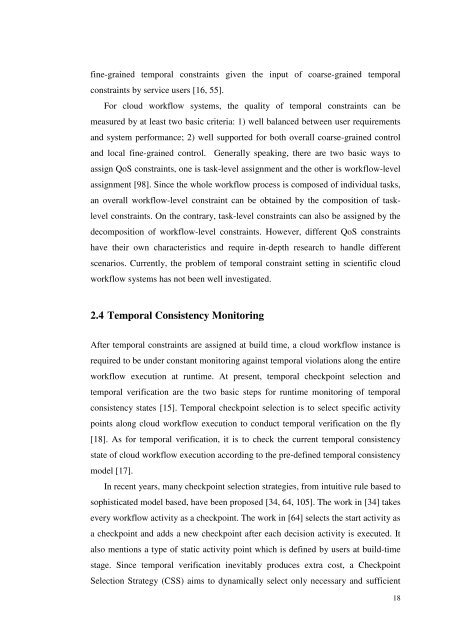Xiao Liu PhD Thesis.pdf - Faculty of Information and Communication ...
Xiao Liu PhD Thesis.pdf - Faculty of Information and Communication ...
Xiao Liu PhD Thesis.pdf - Faculty of Information and Communication ...
You also want an ePaper? Increase the reach of your titles
YUMPU automatically turns print PDFs into web optimized ePapers that Google loves.
fine-grained temporal constraints given the input <strong>of</strong> coarse-grained temporal<br />
constraints by service users [16, 55].<br />
For cloud workflow systems, the quality <strong>of</strong> temporal constraints can be<br />
measured by at least two basic criteria: 1) well balanced between user requirements<br />
<strong>and</strong> system performance; 2) well supported for both overall coarse-grained control<br />
<strong>and</strong> local fine-grained control. Generally speaking, there are two basic ways to<br />
assign QoS constraints, one is task-level assignment <strong>and</strong> the other is workflow-level<br />
assignment [98]. Since the whole workflow process is composed <strong>of</strong> individual tasks,<br />
an overall workflow-level constraint can be obtained by the composition <strong>of</strong> tasklevel<br />
constraints. On the contrary, task-level constraints can also be assigned by the<br />
decomposition <strong>of</strong> workflow-level constraints. However, different QoS constraints<br />
have their own characteristics <strong>and</strong> require in-depth research to h<strong>and</strong>le different<br />
scenarios. Currently, the problem <strong>of</strong> temporal constraint setting in scientific cloud<br />
workflow systems has not been well investigated.<br />
2.4 Temporal Consistency Monitoring<br />
After temporal constraints are assigned at build time, a cloud workflow instance is<br />
required to be under constant monitoring against temporal violations along the entire<br />
workflow execution at runtime. At present, temporal checkpoint selection <strong>and</strong><br />
temporal verification are the two basic steps for runtime monitoring <strong>of</strong> temporal<br />
consistency states [15]. Temporal checkpoint selection is to select specific activity<br />
points along cloud workflow execution to conduct temporal verification on the fly<br />
[18]. As for temporal verification, it is to check the current temporal consistency<br />
state <strong>of</strong> cloud workflow execution according to the pre-defined temporal consistency<br />
model [17].<br />
In recent years, many checkpoint selection strategies, from intuitive rule based to<br />
sophisticated model based, have been proposed [34, 64, 105]. The work in [34] takes<br />
every workflow activity as a checkpoint. The work in [64] selects the start activity as<br />
a checkpoint <strong>and</strong> adds a new checkpoint after each decision activity is executed. It<br />
also mentions a type <strong>of</strong> static activity point which is defined by users at build-time<br />
stage. Since temporal verification inevitably produces extra cost, a Checkpoint<br />
Selection Strategy (CSS) aims to dynamically select only necessary <strong>and</strong> sufficient<br />
18
















